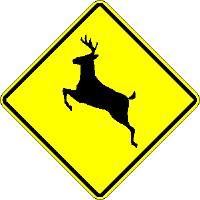

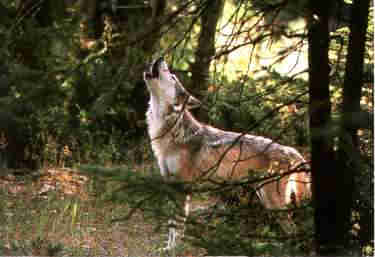
Wolf
The largest member of the wild canine family, wolves live in highly social, structured family packs that can number from two to 20. At full speed, the wolf can run 30 mph, and a wolf pack's territory range is normally 60 square miles, with a pack covering 30-125 miles in a day. The wolf has no natural predator other than man, of whom he is very shy and leery. A wolf's common prey are small animals and birds but they also hunt larger animals such as deer. The wolf provides an important function in nature for while they can kill healthy animals, they naturally seek out the sick, weak, crippled and old animals, leaving only the strong and healthy to reproduce.
Coyote
Probably the most adaptable animal to ever roam the earth, the coyote feeds mostly on squirrels, rabbits and small rodents, but will attack and kill animals larger than itself. It brings down sick and dying large game, and will clean up the remains of dead animals. Their melancholy cry begins with a yipping bark that slides into a drawn out wail. Coyotes have been known to thrive in suburban areas of large cities, but they are generally shy of man.
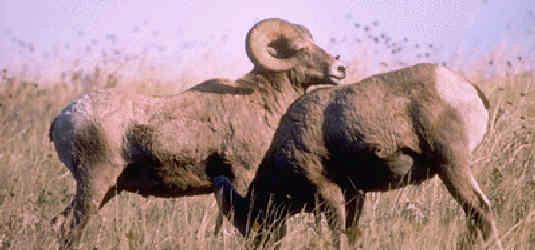
Bighorn Sheep
Surefooted and unique, bighorns live in high-elevation areas with cliffs or rocky outcrops. As one of nature's rock climbers, you'll have to set your sights high to see one!
Moose
The largest members of the deer family, moose weigh 700-1000 pounds, and their size and ungainly looks belie their speed and grace. They are fearless, having no natural enemy of any significance, except man. The male's shovel-like antlers are called "paddles" and are shed every year. Moose are usually found near wet riparian areas.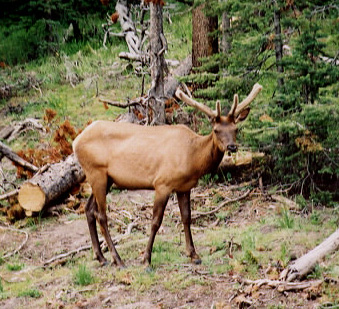
Elk
The Native Americans call this aloof, intelligent, secretive and stately forest dweller the "Wapiti." Originally a prairie animal, they retreated and adapted to the mountains when their habitat was lost to settlers developing the land. Elk spend the spring and summer in the high country, but winter snows force them to lower elevations in search of food. Once you've heard the bugle of a bull elk during the rutting season, you will never forget it.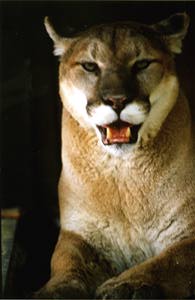
Mountain Lion
This magnificent animal is a rare sight, due to its shyness and exceptional ability to avoid being seen. Also called the puma or cougar, the mountain lion is a wide-ranging predator which covers many miles a day in search of prey. Incredibly fast and strong, it's very much at home in the rugged high country.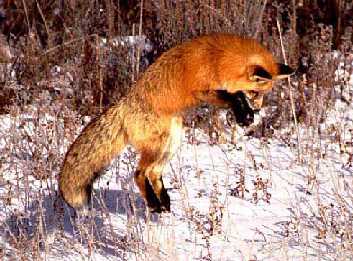
Red Fox
One of my personal favorites, this beautiful, wily creature's Latin name is VULPES VULPES. This name originates from the word "volupes" or twisty foot, since a fox rarely runs in a straight line, preferring to run from side to side to help spread his scent with his tail. The red fox is an omnivore, eating everything from eggs, plants and insects to small rodents, birds and carrion. Foxes can typically be seen during dawn and dusk, and usually along the wooded edges of fields.
Bald Eagle
The only eagle unique to North America, held sacred by the Native Americans as a messenger of God, this majestic bird reigns as our national symbol. The bald eagle can fly 20 to 40 mph and can dive at speeds over 100 mph. The male has a wing span of six feet. It takes 4-5 years for an eagle to reach maturity. Of course, the bald eagle is not really bald...it was named for the white feathers on its head, the word "bald" once meaning "white," not "hairless."
Grizzly Bear
When Lewis and Clark explored the West, as many as 100,000 grizzlies roamed the land from the Mississippi River to the Pacific coast, but by the 1920's, hunting and habitat destruction had reduced the grizzly bear to a few isolated mountain areas scattered across the Western U.S. Today, there are fewer than 1,000 grizzlies in the lower 48 states, occupying less than two percent of their original range. Destruction of habitat remains the biggest threat to the bear. Its silver-tipped fur and shoulder hump are two characteristics that differentiate it from the brown and black bears.
Pronghorn Antelope
The pronghorn antelope is found only on America's Great Plains. It is the only member of its family, Antilocapridae. Smaller than the white-tailed deer, the mature buck weighs from 100 to 130 pounds and the female from 75 to 100 pounds. The male develops large pronged horns which average about 12 inches and are shed each year. The female sometimes develops smaller horns that are rarely as long as her ears. The pronghorn is extremely fast, with a top speed of about 60 miles per hour, and can easily outrun any other animal that tries to catch it. Hence its nickname "Prairie Ghost."
Bison
Often referred to as the American buffalo, bison range from 5 to 7 feet high at the shoulder and may weigh as much as a ton, but they can run up to 35 miles per hour. Both sexes sport the unique large head, shaggy mane, hump on the shoulders, and horns. It is said they once covered North America like a living sea, probably over 60 million at one time.
"Don't Fence Me In"
